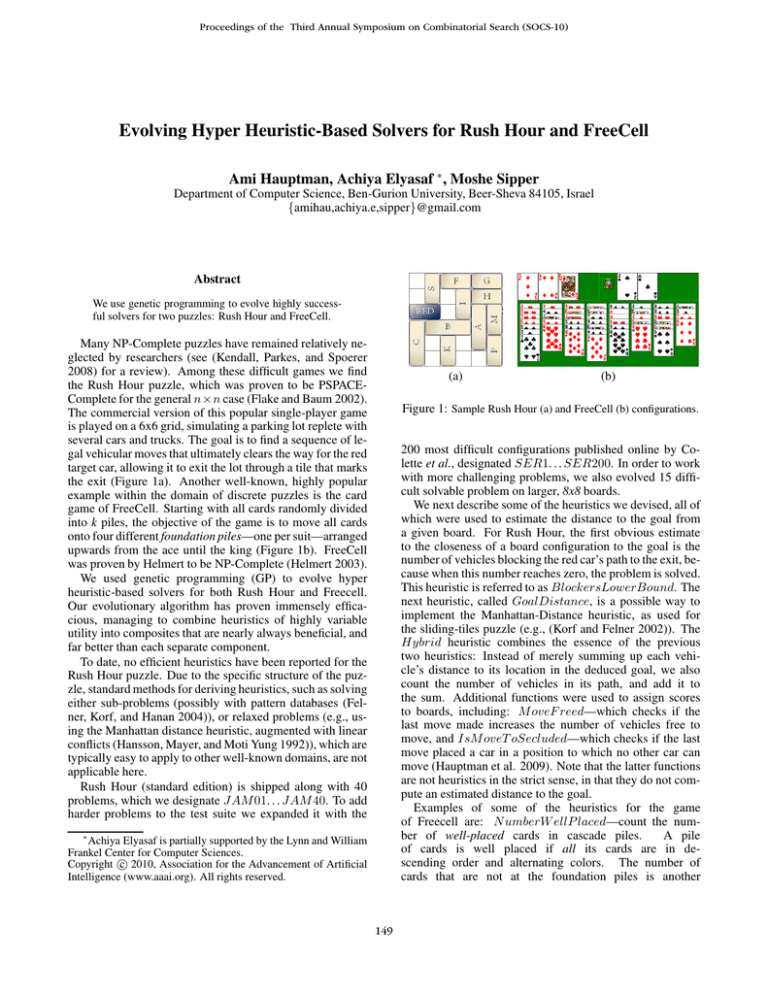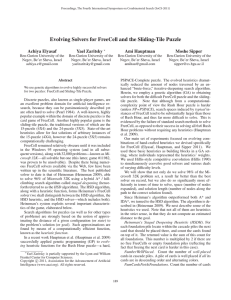
Proceedings of the Third Annual Symposium on Combinatorial Search (SOCS-10)
Evolving Hyper Heuristic-Based Solvers for Rush Hour and FreeCell
Ami Hauptman, Achiya Elyasaf ∗ , Moshe Sipper
Department of Computer Science, Ben-Gurion University, Beer-Sheva 84105, Israel
{amihau,achiya.e,sipper}@gmail.com
Abstract
We use genetic programming to evolve highly successful solvers for two puzzles: Rush Hour and FreeCell.
Many NP-Complete puzzles have remained relatively neglected by researchers (see (Kendall, Parkes, and Spoerer
2008) for a review). Among these difficult games we find
the Rush Hour puzzle, which was proven to be PSPACEComplete for the general n×n case (Flake and Baum 2002).
The commercial version of this popular single-player game
is played on a 6x6 grid, simulating a parking lot replete with
several cars and trucks. The goal is to find a sequence of legal vehicular moves that ultimately clears the way for the red
target car, allowing it to exit the lot through a tile that marks
the exit (Figure 1a). Another well-known, highly popular
example within the domain of discrete puzzles is the card
game of FreeCell. Starting with all cards randomly divided
into k piles, the objective of the game is to move all cards
onto four different foundation piles—one per suit—arranged
upwards from the ace until the king (Figure 1b). FreeCell
was proven by Helmert to be NP-Complete (Helmert 2003).
We used genetic programming (GP) to evolve hyper
heuristic-based solvers for both Rush Hour and Freecell.
Our evolutionary algorithm has proven immensely efficacious, managing to combine heuristics of highly variable
utility into composites that are nearly always beneficial, and
far better than each separate component.
To date, no efficient heuristics have been reported for the
Rush Hour puzzle. Due to the specific structure of the puzzle, standard methods for deriving heuristics, such as solving
either sub-problems (possibly with pattern databases (Felner, Korf, and Hanan 2004)), or relaxed problems (e.g., using the Manhattan distance heuristic, augmented with linear
conflicts (Hansson, Mayer, and Moti Yung 1992)), which are
typically easy to apply to other well-known domains, are not
applicable here.
Rush Hour (standard edition) is shipped along with 40
problems, which we designate JAM 01. . . JAM 40. To add
harder problems to the test suite we expanded it with the
(a)
(b)
Figure 1: Sample Rush Hour (a) and FreeCell (b) configurations.
200 most difficult configurations published online by Colette et al., designated SER1. . . SER200. In order to work
with more challenging problems, we also evolved 15 difficult solvable problem on larger, 8x8 boards.
We next describe some of the heuristics we devised, all of
which were used to estimate the distance to the goal from
a given board. For Rush Hour, the first obvious estimate
to the closeness of a board configuration to the goal is the
number of vehicles blocking the red car’s path to the exit, because when this number reaches zero, the problem is solved.
This heuristic is referred to as BlockersLowerBound. The
next heuristic, called GoalDistance, is a possible way to
implement the Manhattan-Distance heuristic, as used for
the sliding-tiles puzzle (e.g., (Korf and Felner 2002)). The
Hybrid heuristic combines the essence of the previous
two heuristics: Instead of merely summing up each vehicle’s distance to its location in the deduced goal, we also
count the number of vehicles in its path, and add it to
the sum. Additional functions were used to assign scores
to boards, including: M oveF reed—which checks if the
last move made increases the number of vehicles free to
move, and IsM oveT oSecluded—which checks if the last
move placed a car in a position to which no other car can
move (Hauptman et al. 2009). Note that the latter functions
are not heuristics in the strict sense, in that they do not compute an estimated distance to the goal.
Examples of some of the heuristics for the game
of Freecell are: N umberW ellP laced—count the number of well-placed cards in cascade piles.
A pile
of cards is well placed if all its cards are in descending order and alternating colors. The number of
cards that are not at the foundation piles is another
∗
Achiya Elyasaf is partially supported by the Lynn and William
Frankel Center for Computer Sciences.
c 2010, Association for the Advancement of Artificial
Copyright Intelligence (www.aaai.org). All rights reserved.
149
heuristic, dubbed N umCardsN otAtF oundations. The
LowestHomeCard heuristic computes the value of the
highest possible card value (typically the king) minus the
lowest card value in foundation piles.
Using such heuristics and auxiliary functions to render
search more efficient is a difficult task, as it involves solving two major sub-problems: 1) Finding exact conditions
regarding when to apply each heuristic, and 2) combining
several estimates to get a more accurate one.
As we want to embody both application conditions and
combinations of estimates, we decided to evolve ordered
sets of control rules, or policies. The function set included
the functions {AN D,OR,≤,≥} for condition trees and the
functions {×,+} for the value trees. We used the standard crossover and mutation operators, as detailed in (Koza
1994). However, before selecting the crossover or mutation
point, we first randomly selected rules whose conditions (or
values) were to be substituted. Fitness scores were obtained
by performing full IDA* search, with the given individual
used as the heuristic function. For each solved board, we
assigned to the individual a score equal to the percentage
of nodes reduced, compared to searching with no heuristics.
For unsolved boards, the score was 0.
For Rush Hour, not only did we evolve solutions to hard
6x6 boards, we also evolved hard-to-solve 8x8 boards. The
most difficult 8x8 board found required 26,000,000 nodes to
solve with no-heuristic, iterative deepening.
Results for Rush Hour are summarized in Table 1. Overall, evolved policies managed to cut the amount of search
required to 40% for 6x6 boards and to 10% for 8x8 boards,
compared to iterative deepening. We also compared the time
required to solve these 40 problems by humans to the runtime of several algorithms: iterative deepening, Hi (representing the average time of our three hand-crafted heuristics), our hand-crafted policy, and our best evolved policy (Hauptman et al. 2009): All algorithms tested are
much faster than human players, and evolved policies are
the fastest. Evolved policies thus save both search time and
space.
Despite its popularity (Bacchus 2001), and despite there
being numerous FreeCell solvers available via the Web, few
have been written up in the scientific literature. The best
solver to date is that of (Heineman 2009), able to solve
96% of the Microsoft 32K problem suite—a set of 32,000
problems included by Microsoft in Windows 95. Heineman’s algorithm is a hybrid A* / hill-climbing search algorithm called Staged Deepening (referred to herein as HSD).
We used a 2-second time limit per problem instance, under
which limitation the HSD algorithm solves 88.7% of the Microsoft 32K.
We designed a number of evolutionary algorithms to seek
solvers for FreeCell. The top performer that emerged was
coevolution-based GP with policies, which is superior to
HSD in several aspects (Table 2): amount of search, time,
solution length, and number of solved instances.
Table 1: Average percentage of nodes required to solve test
problems, with respect to the number of nodes scanned by
iterative deepening (shown as 100% in the second column).
H1: the heuristic function BlockersLowerBound; H2:
GoalDistance; H3: Hybrid. Hc is our hand-crafted policy devised by combining the basic heuristics, and GP is the
best evolved policy.
Heuristic:
Problem
6x6
8x8
None
H1
H2
H3
Hc
GP
100%
100%
72%
69%
94%
75%
102%
70%
70%
50%
40%
10%
Table 2: HSD vs. our top algorithm—coevolution-based GP
with policies. The first three columns show average amount
of search, time, and solution length, with HSD serving as a
baseline (i.e., 100%). The rightmost column indicates the
percent of solved problems of the Microsoft 32K, with a 2second time limit.
Algorithm
HSD
Evolved Policy
Amount
of Search
100%
41%
T ime
100%
31%
Solution
length
100%
70%
Solved
P roblems
89%
99%
Felner, A.; Korf, R. E.; and Hanan, S. 2004. Additive pattern
database heuristics. J. Artif. Intell. Res. (JAIR) 22:279–318.
Flake, G. W., and Baum, E. B. 2002. Rush hour is PSPACEcomplete, or ”why you should generously tip parking lot attendants”. Theor. Comput. Sci. 270(1-2):895–911.
Hansson, O.; Mayer, A.; and Moti Yung. 1992. Criticizing solutions to relaxed models yields powerful admissible
heuristics. Information Sciences 63(3):207–227.
Hauptman, A.; Elyasaf, A.; Sipper, M.; and Karmon, A.
2009. GP-Rush: Using genetic programming to evolve
solvers for the Rush Hour puzzle. In Proceedings of the Genetic and Evolutionary Computation Conference (GECCO
2009), 955–962. ACM.
Heineman, G. T. 2009. Algorithm to solve FreeCell solitaire games. http://broadcast.oreilly.com/2009/01/januarycolumn-graph-algorithm.html. Blog column associated with
the book “Algorithms in a Nutshell book,” by G. T. Heineman, G. Pollice, and S. Selkow, O’Reilly Media, 2008.
Helmert, M. 2003. Complexity results for standard
benchmark domains in planning. Artificial Intelligence
143(2):219–262.
Kendall, G.; Parkes, A.; and Spoerer, K. 2008. A survey of
NP-complete puzzles. International Computer Games Association Journal (ICGA) 31:13–34.
Korf, R. E., and Felner, A. 2002. Disjoint pattern database
heuristics. Artificial Intelligence 134(1-2):9–22.
Koza, J. R. 1994. Genetic Programming II: Automatic Discovery of Reusable Programs. Cambridge Massachusetts:
MIT Press.
References
Bacchus, F. 2001. AIPS’00 planning competition. AI Magazine 22(1):47–56.
150








